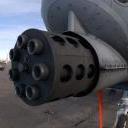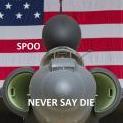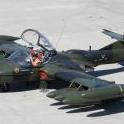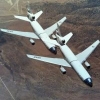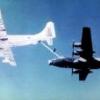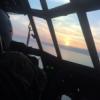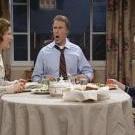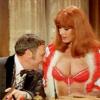Leaderboard
Popular Content
Showing content with the highest reputation on 03/07/2013 in all areas
-
Fini Flight. You either know it will be your fini flight or you don’t. I had mine planed out for months. “Viper 2, traffic eleven o’clock , 3 miles slightly high. Slow mover.” “2’s tally” That is the first thing he has said in the last 30 minutes. Right after taking the runway I checked him in on the departure frequency and he had not said another word since. Radio discipline is absolutely necessary in our job, something I did not realize fully until flying over the skies of Iraq. Working with JTAC’s, air controllers other flights, predators, helicopters and humvees all on the same frequency - there is no time for small talk. Every word needs to have a meaning. Brevity. There are no umms or aahhhs – nothing extraneous. Think about what you are going to say and find the 3-1 term to say it. A book a thousand pages long with a chapter specifically written on how to say things. Every flight in the last five years we have debriefed to it and so far this flight is going well. An HH-60 Blackhawk helicopter passes motionless a thousand feet above our flight, the workhorse taxi of Iraq. The doors are open and a few dudes are sitting on the edge with their boots hanging into the air. One gives a hang loose sign as we rocket past at 500 knots. Our flight is at 500 feet and 500 knots, hugging the trees, weaving and bobbing in and out of the valleys. Nap of the earth flying using the terrain to hide from the SAM threats that abound around us. The General Electric I am strapped to is not even sweating. It will still give me 300 more knots with a 2 inch flick of the throttle. I am covering a mile every 6 seconds but it is comfortable now. I have time to check out houses and notice fisherman in the lakes. What was a blur a few years ago has slowed down immensely and given me time to think well ahead of the jet. I have a map in my left hand and a photo of the target along with the attack we will be using strapped to my knee. A quick study of the terrain we will see will pay huge dividends in about 5 minutes. I have my pen handy to jot down any notes the ground controller will give me when we check in. All this with a 2 second time to impact the earth with any wrong moves. The laws about texting and driving always crack me up – we are on a different level. I was 3 seconds late on my last turn point and need to push it up a little to get there on time. I have a two minute window to deliver, but bombs on target on time to the second is the goal. This will be the lat time I drop bombs for a long time and I want to shack the SA-6 site on the first run attack. The next plane I fly won’t do low levels and I know I am going to miss the Viper. I have had an outstanding time with my squadron the last few years and have been mentored by some of the finest pilots in the Air force. My final flight won’t be without some tears, I’ll be leaving some great friends and my first love – the F-16. The plan is a 10 LAT, Rip 6, 1 pass and haul ass. 1 shot with no re-attacks. Nothing worse than stirring up the hornets nest with the sound of a NASCAR race and going through dry. A re-attack with an aware enemy is much more risky. The element of surprise is a tactic that worked for Ghengas Kaahn and a flight of fighters alike. The initial point looks exactly as briefed, a small bridge over the creek at a low point in the valley. We are going to egress back over the mountains and be gone and out of sight just as quick as we arrived. Ghosts of destruction. 5 miles out, we still cannot see the target at these low altitudes. Viper 2 checks 45 degrees to the right. I immediately check 30 and climb 15 degrees nose high. Things are starting to happen fast. Off the left is an opening in the road and as I climb, an SA-6 is just becoming visible through the trees. His radar just woke up to the fact that I was there, the operator woken up by an alarm and the computer asking for consent to fire. Off my right, Viper 2 squares up to the target on a simultaneous attack. He needs to pickle before my bombs impact so he can see where to drop. I roll inverted and point. 10 degrees low, target just below the nose. Track. Small adjustment left. Wait. I am only 1000 feet above the ground with the target rapidly approaching. These are dumb bombs. Old school. They go where you pickle and if you miss you miss. No fancy lasers or GPS to put them back on track. The sport of kings and a skill the CAF is rapidly losing with less flying and the adaptation of high tech guided weapons. I have less than 5 seconds to figure all this out. 520 knots, heading down hill. Watch the throttle. Aim. Put the thing on the thing. Let the green stuff do its magic, the hamsters working overtime to calculate it out. Warheads on foreheads. Whatever. The pipper tracks right over the center. Pickle. Hold. Track. The death dot passes squarely across the target and is moving rapidly. In milliseconds, 6 bombs ripple off the jet in quick succession. 2 lofts his bombs in from a mile out so he doesn’t get nailed by the frag of mine. We both pull 5 g’s in an aggressive left hand turn, back to formation, back down low and back out of sight. Gone. Blue Death. 12 BDU bombs leaving a pile of hair, teeth and eyeballs in our wake…. A perfect training mission and a perfect way to end my career in the plane I have come to love. The end of the Fini Flight is usually met with the same enthusiasm on the ramp. It is traditional for friends and family along with the entire squadron to meet the jet as it taxis in. Long over are the days of multiple burner low approaches inches over the squadron building but there still is some unique style to ending ones career in a particular fighter. I have seen guys taxi back with gorilla masks on, blow up dolls fully inflated and my personal favorite – helmet removed and replaced with one of those beer caps, 2 Bud Lights strapped to the sides of a yellow plastic ball cap with a straw going to both. The canopy opened on his jet and he tossed a dozen empties over the side. “Thank God he didn’t crash” is all the commander could say. “Could you imagine the accident report on that one with a case of beer in the wreckage.” It is not over with the landing, as the pilot takes his last step off the ladder it begins. Some try to run but most know to stay put. My squadron gets one of the cops to handcuff pilots to the tie down rings on the ramp just to make sure they don’t go anywhere. Kids get the small fire extinguishers, and mom gets the hose from the fire truck to soak the pilot down. This is a fantastic exercise when snow is on the ground – as it turns out, the rubber, watertight dry suit we wear during the winter months is also fantastic at holding water on the inside. Often times, someone will unzip the dry suit, shove the fire hose in, sts, fill it up with water and zip it back closed. Probably 50 gallons or so get trapped and freezing temperatures offer no reprieve. This much water weight will pin the pilot to the ground until the water drains out of his sleeves. A bottle of champagne is shared by the bros, we call the pilot a quitter and generally throw a big party in the bar that evening. Tradition, and something every fighter pilot should have. I had flown that same flight a hundred times but my planned fini flight in the Viper did not happen that way. None of it. Not even close. Back in November of 2009, my buddy Monty had his fini flight as well but he didn’t know it. A few days after his last flight, on an off day, he was out in his front yard doing a little lawn maintenance when a Pontiac GTO went out of control and jumped the curb up into his yard killing him instantly. He died trimming his trees on a day off. Unbelievable. Fighter pilots know exactly how they will part the surly bonds of earth. It happens one of two ways. You die telling stories of your past glory at a relatively young old age from liver complications from the whiskey you drank to help make those stories entertaining – OR – you plow in at tremendous speed, out of control and on fire, completely content in the fact that you just took 5 flankers with you. A national frickin hero. A decorated combat veteran and one of the finest fighter pilots this world has ever known did not go down in a blaze of glory with his hair on fire. He was not slain by AAA even though it had been aimed at him. He was not damaged by SAM’s even though they were trained on his jet. He has had countless emergencies and brushes with death over his decade and a half flying fighters and he came out unscathed. He was a phenomenal fighter pilot, well respected in the community, and unfortunately he did not go out on his own terms. Monty was the kind of pilot that everyone wanted to follow into battle. As one of my early F-16 instructors, he was unanimously voted as one of the best. He had an easy going personality combined with an unbelievable knowledge of tactics and golden hands that made him an extremely talented aviator. He was also a good friend and mentor and played a tremendous part in my follow on assignment. I had dinner with he and his wife just a week earlier. 3 years later and I still have trouble making sense of the way he parted this earth. Tragic. Monty grew up in Ohio and Ohio is where he wanted to be buried. We flew jets out to Selfridge Michigan the next weekend to honor him with a missing man fly over of his funeral. Unfortunately, just after we landed, the storm of the year started to pass through. Detroit and Chicago O’Hare shut down and the entire country was being crippled by a massive front. Snow had just started falling when we landed, the forecast was getting worse and it looked as if there would be absolutely no way to get airborne the next day. We chatted with the crew at base ops regarding the next day’s flight and they were determined to do whatever it took to make it happen. They knew of the accident and knew what it would mean to Monty to get us airborne. We passed 2 dozen accidents on the way to the hotel that night, the snow had turned to freezing rain. Hell really had frozen over, there was no chance the flyover would happen. We met Monty’s family that evening and they were just as good of people as he was. I had been on a fishing trip with Monty and his dad down in Florida a few months prior and his old man was devastated. They were true friends. His wife was also a good friend of the squadron. A fantastic woman, also an Air Force pilot, who lost her husband far to early in their marriage. There was nothing to say so we talked about all the good times. They had all thanked us for bringing the jets out and understood that we wouldn’t be able to fly. The next morning we pressed out to the airport anyways. The storm had been devastating, cars had been in the ditch all night from sliding on the black ice and power outages were widespread from iced over trees falling on power lines. It dumped another 1.5 feet of snow on top of the ice over the night. The weather was still a few hundred feet overcast with freezing fog and mist. 45mph is all we dared to go but we had to at least try and make it happen. When we pulled up to the airport we were amazed at the sight of several snowplows already hard at work. The base ops manager said they called in extra employees and came in early. If the weather cleared, the runway would be ready. I have never seen an F-16 iced up as badly as these jets were. They looked pathetic and crippled with hundreds of ice sickles jetting off every point that water ran off. The wings were covered in snow and under that was a layer of frozen ice. The manager said the de-ice truck was ready when we were. We made the call to fire the jets up. There was no chance the weather would clear, but we felt we owed it to Monty to try. The truck de-iced us and we hobbled our way out to the runway single file. The cleared area was barely wide enough for an F-16 to sneak through. At the end of the runway we waited. And waited. We were all watching our watches, waiting for the no later time knowing the funeral had already started. We had about a half hour to go until it would be too late. None of us said a word. At the 29 minute point, tower called and said we had the absolute minimum weather we needed to lift off. “1’s Ready.” “2’s Ready.” “3’s Ready.” “Tower, Viper flight ready” “Good luck boys, cleared for takeoff.” The tower controllers knew the importance of this flight as well. It was dark, gray and dreary. Absolutely miserable out. Off we went a minute later and immediately into the weather. A few minutes into the climb, lead broke the silence. “Well fellas, here we go.” We were in the weather forever. If the ceiling was the same over the cemetery, there was no way we would be able to do the flyover. We pressed on anyways. Passing through 25,000 feet we finally broke through the clouds. The misery and dreariness of the weather below was left behind and we broke out into a crystal clear blue sky above. It was a beautiful sight to see the sun, but a white blanket of thick clouds stretched out as far as we could see. The satellite image showed it stretched for a thousand miles. 100 miles to go and there was no hole in site. There was no chance this was going to happen but we owed it to Monty to press on anyways. A check of the weather with the center controller said the clouds in the area were overcast from 400-800 feet with 1-2 miles of visibility. “Viper flight, cleared to descend to 1500’. Good luck fellas.” The center controller knew how important this flight was as well. Down we went, back into the black abyss. The blue sky disappeared and the gentle white clouds quickly turned grey and then black. The weather sucked but we pressed down anyways. “Viper flight, cleared to 1000’” On the AUX radio, lead called our buddy with a handheld on the ground. “It doesn’t look good fellas, I’d estimate a few hundred feet at best.” 1000’ was the minimum vectoring altitude in the area and as low as we are legally allowed to go. If the clouds were at 800’ we would have to call it a day. Miraculously, and against all odds, we broke out of the weather at 1500’. We were in a radar trail formation with 2 miles between each jet. One by one we popped out of the weather and slowly joined up. We had 5 minutes of loiter time and we were holding about 20 miles away. There was still a wall of weather between us and where we were going. We were in a sucker hole, just wide enough for us to fumble around and wait. It was still a long shot even though we were so close. At the 4th minute, the weather parted and a rainbow appeared right above the cemetery. “You see that Rainbow?” “Yep. This is meant to happen” The rainbow, no kidding ended right on the mark point for the cemetery. Viper 2 was on the left wing, I was on the right. In between lead and myself was an empty space for another Viper. Where Monty’s jet belonged. The missing man. We flew slowly over his funeral during taps. His broken wings put back together and placed on his chest in the coffin. His body was on the ground but there is absolutely no doubt that we were actually flying on his wing that chilly morning. There is no way that flyover should have happened, but somehow it did. Monty was watching over us and he wouldn’t have wanted it any other way. After we flew over, the clouds closed up and we were again swallowed by the weather. Our good buddy was laid to rest with a proper send off. He dedicated his life to the service of our country, it is the least we could do to pay him back. We had a few more beers that night and reminisced more about our friend. Old Monty stories turned up from other squadrons that we had never heard. Different time, different place, but same old Monty. What a great guy. The next afternoon the weather finally broke. I led the lonely flight home and landed at night. A handful of pilots met me at the jet, the rest were still in transit from Ohio. There was no ceremony, no fire hose, no pictures, or Champaign. A simple handshake to a few of my good friends to commemorate my fini flight in the F-16 was all I needed. That long flight home was my last in the mighty Viper. “Here’s To Monty” we all said in unison. I rubbed my hand down the nose of the jet for the last time and took my gear inside. I cut my teeth on the Viper, and Monty was a big part of that. Not by any means what I planned for a fini, but I wouldn’t have it any other way. I miss that bird, but I miss my friend more. I’ll see him again the next time I fly. Here’s To Monty.3 points
-
they're actually measured in units of NBh (Nav Butthurt) on a scale of 1 (the pilot let me fly today!) to 10 (i'll never be a general)2 points
-
TIB 3-1 is a great read. Starts with BFM, Basic Fabulous Manuevers, for individuals. Stuff like jazz hands. The moves to more advanced concepts like ACM, Assembled Cast Manuevering, which covers singing and dancing as a group.2 points
-
what is the incentive for those on the receiving end of the redistribution of wealth to wean themselves off of it?2 points
-
The 1st Reconnaissance Squadron is the United States military's oldest flying unit, dating from 5 March, 1913. Organized for security along the U.S. and Mexico border, the 1st Aero Squadron went into action on 16 March 1916 as part of General Pershing's punitive expedition in northern Mexico. The 1st Aero Squadron thus became the first tactical aviation unit in American military history. Upon U.S. entry into World War I, the squadron departed for France and Lt. Stephen W. Thompson scored the squadron's first aerial victory on 5 February 1918, which was also the first air to air kill by a U.S. military member. Through the remainder of Great War, the 1st supported ground forces in battles at Chateau-Thierry, along the Aisne and Marne Rivers, and finally the bloody Meuse-Argonne offensive. At the time of the Armistice, pilots of the 1st Aero Squadron had recorded 13 aerial victories, commemorated by 13 Maltese crosses surrounding the squadron emblem. Following the war, the 1st was redesignated as an Observation Squadron and stationed at Mitchel Field, New York. In 1921 the squadron was temporarily assigned to the 1st Provisional Air Brigade, under Brigadier General William "Billy" Mitchell which gained attention for sinking the German battleship Ostfriesland. The squadron became the 1st Bombardment Squadron on 1 March, 1935 during the buildup to World War II and found itself flying out of Panama and Trinidad on defensive antisubmarine patrols. In 1944, the squadron converted to the new B-29 Superfortress, departed for combat in the Marianas Islands and completed 71 combat missions between February and August 1945. From 1948 until 1954, the 1st underwent many changes, eventually converting to the B-47 in 1954 and flying out of Mountain Home AFB, Idaho until 1966. At that time the squadron transitioned to the new SR-71 and became the 1st Strategic Reconnaissance Squadron at Beale AFB, California. The 1st flew operational missions with the Blackbird starting in 1968, including over North Vietnam and North Korea, until retiring the aircraft in 1990. That year the squadron transitioned to a training role, responsible for the selection and training of U-2 pilots using the TU-2S two-seat trainer and redesignated the 1st Reconnaissance Squadron in 1994. Finally, in 2008 the squadron added the role of training pilots and sensor operators for the RQ-4 Global Hawk. Throughout its history, the 1 RS has flown 47 different airframes while operating from 52 locations throughout the world.1 point
-
Technique: delete ALL emails upon return from leave. If they are important, they will be resent1 point
-
Hold on before you throw all bands under the bus. Many of you rip our willingness to abandon heritage, yet you wholesale throw the baby out with the bathwater. Please be a little more "surgical" if you ever become a flag officer, and have the power to influence. Case in point: https://en.wikipedia.org/wiki/United_States_Marine_Drum_and_Bugle_Corps https://drumcorps.mbw.usmc.mil/ These guys still train a basic infantrymen. A Marine friend was telling me about a change of commands in the USMC. Big production, with lots of good tradition, including the band and marching. He mentioned a commander that didn't get the band. Everyone was saying "what did he do to screw up and get the band turned off?" It turns out there was a pressing need for the band members to deploy as riflemen, and for a period, that overrode the need for the band. Seems that they have a good perspective.1 point
-
1 point
-
If everybody is wealthy, no one is. Just like, if everyone is a special snowflake, no one is.1 point
-
Your view of the role of government is greatly different than my view of government's role. Although your ideals are certainly noble, they're unsustainable in the long run and are economically damaging for all the reasons we've previously discussed. I don't have a problem with taxation, spending, or regulation. That's the how behind the government doing its job. The argument here is what the government's job is. My view is that the government exists as the caretakers of our national community, to perform the tasks that individuals and smaller communities/business cannot do for themselves. These tasks include protection of individual liberties and agency/opportunity, provision for trade and commerce, defense from foreign and domestic threats, legislative and judicial oversight, assistance in recovery from grave disasters (beyond the scope and capability of local communities), developing/protecting baseline standards for national resources, interfacing with foreign nations, and other necessary tasks to administer their constitutional duties. Redistribution of wealth, promoting populist agendas, and political brinkmanship are not core government duties. When politicians stretch the role of government beyond its basic purpose, unintended negative consequences always follow.1 point
-
Giving poor people the gift of money through redistribution of wealth does nothing to raise them above the poverty line (long term). It only does three things. 1: Temporarily assists with basic survival needs. 2: Creates a dependency on government handouts with an insatiable appetite for more. 3. Raises the poverty line through induced inflation to encompass all of the previous poor and more of the middle class. There are other negative effects, but these are the ones that directly affect those welfare is supposed to help.1 point
-
1 point
-
I understand that bands are if not heritage, at least tradition. Tactical Application of TIB Resources should involve sending them into a minefield to clear it by hand.1 point
-
If I ever meet someone who argues for "Tactical Application of Band Resources" they will get kicked in the balls.1 point
-
This is on the aft side of the bulkhead separating the flight deck from cargo compartment of an HC-130P at KABQ. While not exactly nose art, still figured it fit the intent of the thread. Untitled by bronxbomber252, on Flickr1 point
-
That is awesome. The passing of that generation reminds me of a Ronald Reagon quote: Freedom is never more than one generation away from extinction. We didn't pass it to our children in the bloodstream. It must be fought for, protected, and handed on for them to do the same, or one day we will spend our sunset years telling our children and our children's children what it was once like in the United States where men were free.1 point
-
Great post, Spoo! I believe we are the oldest squadron in North America,... uncontested. I seem to remember claiming we were the oldest in the world, but Steve Davies said the British had a balloon squadron before us. A "balloon squadron" is a silly claim, and doesn't count. So, we still win. (No offense, Steve!)1 point
-
I know I've made some mistakes in the past but I want to make up for them. I want to be good.1 point
-
1 point
-
I found the problem: "The jets are built by Lockheed Martin and powered by Pratt & Whitney engines."1 point





